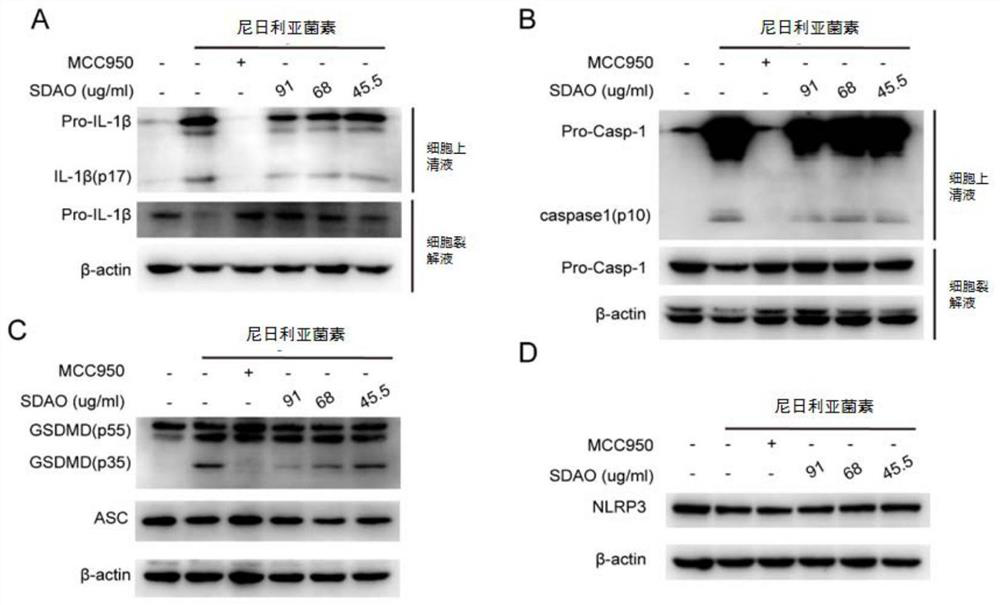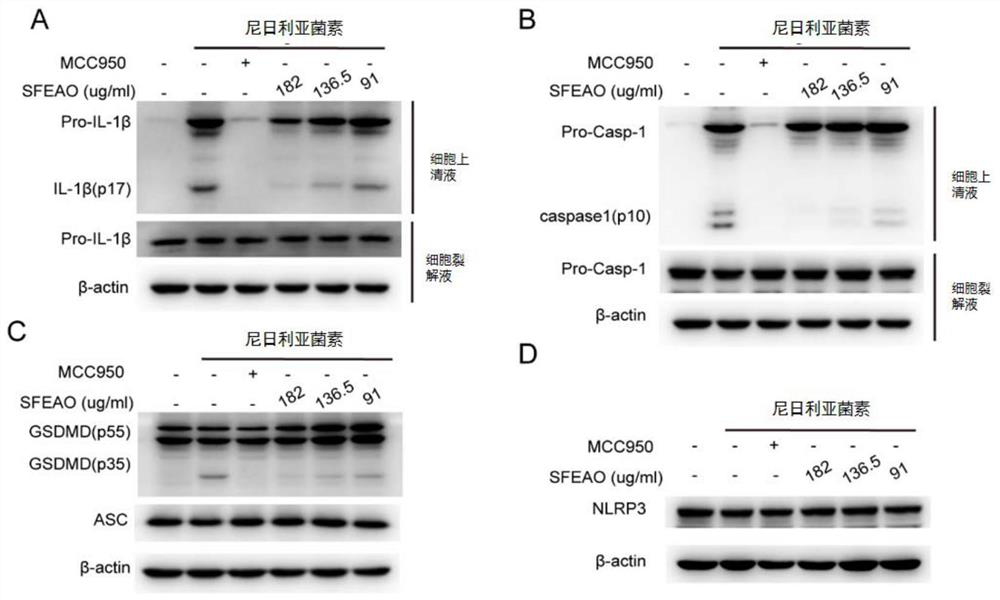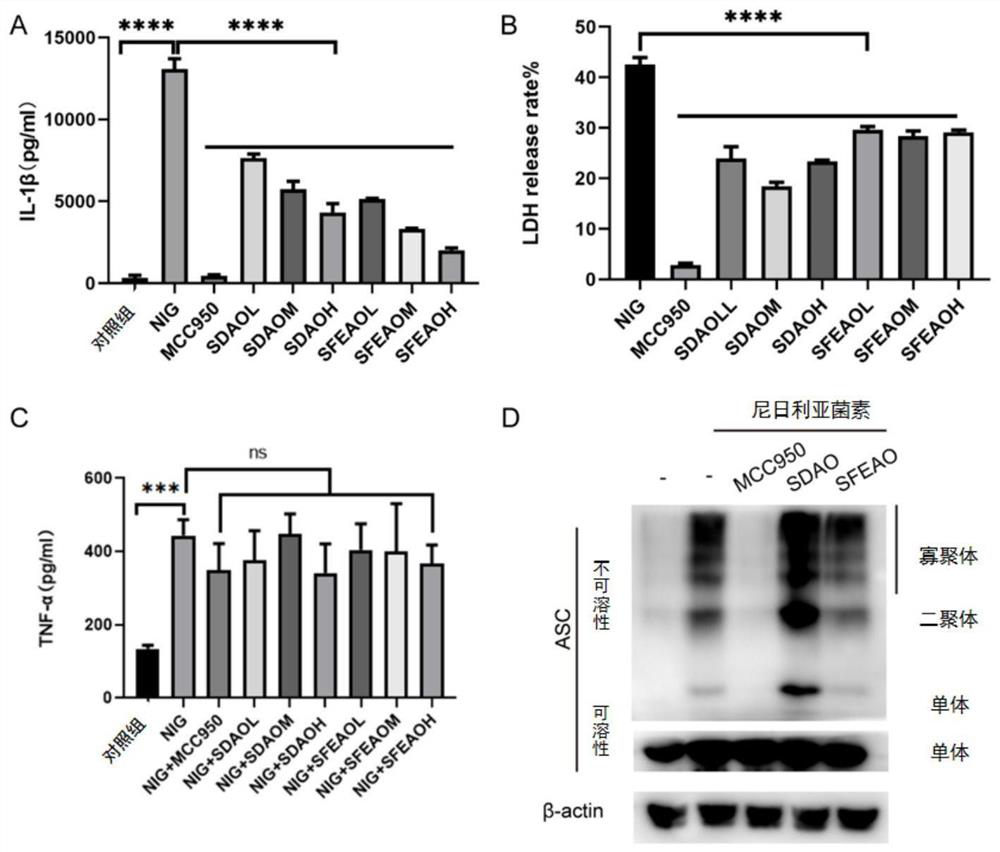Application of folium artemisiae argyi volatile oil to inhibition of activation of NLRP3 inflammasomes
A technology of Artemisia argyi volatile oil and inflammasome, which is applied in the field of biomedicine, can solve the drug records or reports that have not given technical inspiration, no research reports on the anti-inflammatory mechanism and target of Artemisia argyi volatile oil inflammasome activation And other issues
- Summary
- Abstract
- Description
- Claims
- Application Information
AI Technical Summary
Problems solved by technology
Method used
Image
Examples
Embodiment 1
[0026] Embodiment 1: Extraction of Folium Artemisiae Argyi volatile oil by steam distillation
[0027] Take 500g of naturally dried Artemisia argyi leaves, soak in distilled water for 2h, and then heat and extract them by steam distillation. After refluxing for 4 hours, the volatile oil was separated and dried by adding a small amount of anhydrous sodium sulfate to obtain 2ml of blue-green volatile oil with strong aroma. The calculated yield is 0.4% based on the volume (ml) of the volatile oil extracted per gram of Artemisia argyi.
Embodiment 2
[0028] Example 2: Supercritical CO 2 Extraction of Artemisia argyi volatile oil
[0029] Take 500g of Artemisia argyi leaves that are naturally dried, pulverize them with a pulverizer, and put them into a supercritical extraction device; turn on the water bath to make the extraction device reach the set temperature (55°C); 2 , replace the air in the system clean; turn on the compressor, adjust the pressure in the extractor to the required pressure (25MPa); adjust the outlet valve of the extractor; maintain the system in this state for 60min, open the separator, take out the extract, and weigh it; After the extraction is complete, turn off the compressor and cylinder, and vent the CO 2 , take out the crude product of volatile oil. Add the extracted Artemisia argyi volatile oil into 2 times the amount of absolute ethanol, stir and place it overnight, vacuum filter to remove the precipitated waxy components, recover the filtrate under reduced pressure at 30°C to obtain 5.6ml of...
Embodiment 3
[0030] Example 3: Inhibition of nigericin-induced NLRP3 inflammasome by extracting volatile oil from Artemisia argyi leaves by steam distillation
[0031] Will 8×10 6 THP-1 cells (purchased from ATCC) were inoculated in a 60mm cell culture dish, and 0.5 μM PMA was used to induce cell adhesion, and the culture dish was placed in 5% CO 2 , Cultivate overnight in a 37°C cell culture incubator. The next day, culture medium was replaced with serum-free medium. The cells were divided into control group, nigericin (purchased from Invivogen, dissolved in absolute ethanol to make 10 mM stock solution, and then diluted to working solution concentration with culture medium) treatment group (10 μM, 1 h), MCC950 treatment group (positive The control group was pretreated with 20uMMCC950 for 30min, then treated with 10uM nigericin for 1h), and the SDAO treatment group (91, 68, 45.5ug / ml steam distillation extraction of Artemisia argyi volatile oil pretreated cells for 1h, and then treated ...
PUM
 Login to View More
Login to View More Abstract
Description
Claims
Application Information
 Login to View More
Login to View More - R&D
- Intellectual Property
- Life Sciences
- Materials
- Tech Scout
- Unparalleled Data Quality
- Higher Quality Content
- 60% Fewer Hallucinations
Browse by: Latest US Patents, China's latest patents, Technical Efficacy Thesaurus, Application Domain, Technology Topic, Popular Technical Reports.
© 2025 PatSnap. All rights reserved.Legal|Privacy policy|Modern Slavery Act Transparency Statement|Sitemap|About US| Contact US: help@patsnap.com



